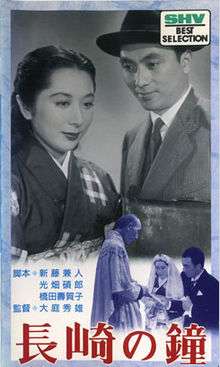The Bells of Nagasaki
 The Bells of Nagasaki | |
| Author | Takashi Nagai |
|---|---|
| Original title | Nagasaki no Kane |
| Translator | William Johnston |
| Country | Japan, United States |
| Language | Japanese, English |
| Genre | Non-fiction Essay |
| Publisher | Kodansha International |
Publication date | January 1949 |
Published in English | August 1994 |
| Media type | Book, Music, Film |
| Pages | 118 |
| ISBN | 978-4-7700-1845-8 |
| Nagasaki no Kane | |
|---|---|
 The Bells of Nagasaki | |
| Directed by | Hideo Ōba |
| Written by | Takashi Nagai |
| Starring |
Masao Wakahara, Yumeji Tsukioka, Keiko Tsushima, Osamu Takizawa, Kōji Mitsui |
| Music by | Yuji Koseki |
| Cinematography | Toshio Ubukata |
| Edited by |
Kaneto Shindō, Sekiro Mitsuhata, Sugako Hashida |
| Distributed by | Shochiku Ōfuna |
Release dates | September 23, 1950 |
Running time | 94 min. |
| Country | Japan |
| Language | Japanese |
The Bells of Nagasaki (長崎の鐘 Nagasaki no Kane) is a 1949 book by Takashi Nagai. It vividly describes his experiences as a survivor of the Atomic bombing of Nagasaki. It was translated into English by William Johnston. The title refers to the bells of Urakami Cathedral, of which Nagai writes:
These are the bells that did not ring for weeks or months after the disaster. May there never be a time when they do not ring! May they ring out this message of peace until the morning of the day on which the world ends.'
Initially, the book was refused publication by the American forces occupying Japan, until an appendix was added describing Japanese atrocities in the Philippines. This appendix was later removed.
Records and CDs
- July 1, 1949, Song by Ichiro Fujiyama, Mariko Ike, Written by Hachiro Sato, Composed by Yuji Koseki
- September 1949, Song by Yoshie Fujiwara, Written and Composed by Kazuo Uemoto
- 1996, Song by Yumi Aikawa, Composed by Yuji Koseki
Film
Released September 23, 1950, Produced by Shochiku
Directed by Hideo Ōba
Scripted by Kaneto Shindo, Sekiro Mitsuhata, Sugako Hashida
Composed by Yuji Koseki
Cast
- Masao Wakahara as Takashi Nagai
- Yumeji Tsukioka as Midori Nagai
- Keiko Tsushima as Sachiko Yamada
- Osamu Takizawa as Professor Asakura
- Kōji Mitsui as Yamashita
Modern retelling
In 2011, UK film Production Company Pixel Revolution Films announced plans to produce a film on the life of Dr. Nagai. Directors Ian and Dominic Higgins cited The Bells of Nagasaki (the book) as one of the main inspirations for making the film. The film is titled All That Remains and is due to be released late 2015 or early 2016. It is the first Western film to deal directly with the atomic bombing of Nagasaki.[1]
See also
References
External links
- Nagai Takashi Memorial Museum-Nyokodo
- NHK Peace Archives
- Pixel Revolution Films 2015 film production on the life of Takashi Nagai